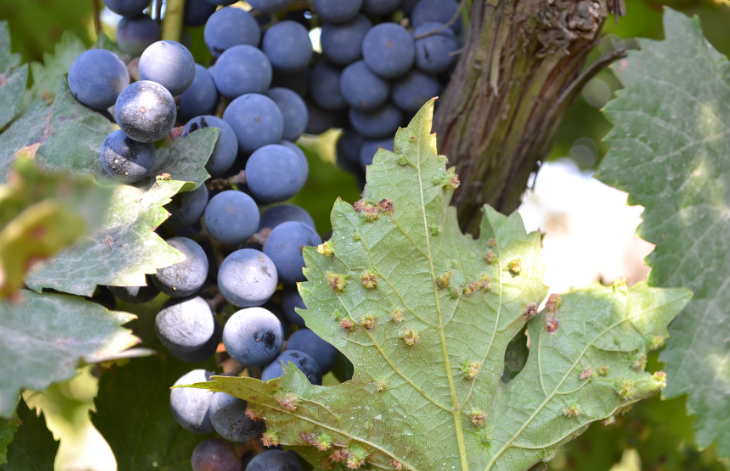A century and a half ago an alien insect alighted in Europe.
一個半世紀以前,一種外來昆蟲飛落歐洲。
It displaced millions, ruined local economies and forced scientists, politicians and ordinary folk into a frenzy of defensive activity.
它讓數百萬人流離失所,對當地經濟造成破壞,還迫使科學家、政治家和普通民眾陷入瘋狂的防御活動。
Phylloxera, a member of the group known to entomologists as Hemiptera, or "true" bugs
根瘤蚜蟲,昆蟲學家口中半翅目家族的一員,或稱真蟲
(as opposed to all the other critters known colloquially as bugs),
(與所有其他他俗稱蟲子的生物截然相反),
appeared in France in the 1860s and proceeded to eat its way through many of the Old World's vines.
于19世紀60年代出現在法國,并逐漸侵蝕了許多舊世界的葡萄藤。
It then spread to pastures new. It was first recorded in Australia in 1875 and in South Africa in 1886,
然后蔓延到新的地方。最早的記錄是在1875年的澳大利亞以及1886年的南非,
threatening similar devastation to the vineyards of those European colonies.
對歐洲殖民地的葡萄園造成了類似的破壞威脅。
Eventually, French and American scientists found a solution by grafting European vines onto the imported roots of American ones.
最終,法國和美國科學家找到了一個解決辦法,他們把歐洲的葡萄藤嫁接到美國葡萄藤的根上。
Now, a more recent group of French and American researchers report in BMC Biology that they have sequenced phylloxera's genome,
近期,法美研究團隊在《BMC Biology》上報告稱,他們對根瘤蚜蟲的基因組進行了排序,
and that hidden within this lie clues to the insect's origins and spread.
并且基因組中隱藏著這種昆蟲起源和傳播的線索。

Nineteenth-century agronomists rapidly divined that phylloxera had come from North America.
19世紀的農學家迅速推斷稱,根瘤蚜蟲來自北美。
That fact provided the rationale behind their graft-based answer to the problem—which is still all that stands between cultivated vines and the bug.
這一事實為他們通過嫁接解決問題提供了理論基礎——這個問題仍是種植葡萄與這種昆蟲之間的唯一障礙。
This is that having co-evolved with the insect, American vines had developed resistance to it.
也就是說,在與這種昆蟲共同進化的過程中,美國的葡萄樹已經對它產生了抗性。
But where exactly it came from on that continent, nobody knew.
但是,沒有人知道這種昆蟲到底來自那個大陸的哪個地方。
One theory held British gardeners responsible because they had brought wild American vines to Europe for decorative purposes.
一種理論認為英國園丁因為此負責,因為他們將野生美國葡萄藤作為裝飾品帶到了歐洲。
From Britain, this theory went, phylloxera reached the European mainland via the south of France, the first place where it devastated vineyards.
該理論認為,根瘤蚜蟲從英國經法國南部傳入歐洲大陸。它首先是破壞了法國的葡萄園。
That, though, turns out to be a calumny against les Anglais.
但事實證明,這是對英國人的誹謗。
By comparing the genetic sequence of European phylloxera with those of populations from wild vines in the United States,
通過將歐洲根瘤蚜蟲的基因序列與美國野生葡萄藤的種群的基因序列進行對比,
Claude Rispe and Fabrice Legeai of the French National Research Institute for Agriculture, Food and the Environment (INRAE)
來自法國國家農業、食品和環境研究所(INRAE)的Claude Rispe和Fabrice Legeai
and their colleagues have narrowed the search to the once-French territory of the Mississippi Valley
以及他們的同事將研究范圍搜索范圍縮小到曾經屬于法國的密西西比河谷
(the upper Mississippi, to be precise—though one of the paper's authors,
(準確的說是,上密西西比河——雖然該論文的作者之一,
Paul Nabity of the University of California, Riverside, plans to keep following the river south, sampling phylloxera as he goes, so the matter is not closed).
美國加州大學河濱分校的Paul Nabity計劃繼續沿著河流南下,對根瘤蚜進行取樣,所以這個任務還沒結束)。
The evidence is that there is a striking similarity between the European sequence
證據表明,歐洲基因序列與野生葡萄藤——河岸葡萄——
and that of two phylloxera populations on a wild vine called Vitis riparia in Wisconsin and Illinois.
的兩個根瘤蚜蟲群(分別在威斯康星州和伊利諾斯州)的基因序列之間存在驚人的相似性。
This is enough, Dr Nabity says, to indicate that V. riparia was the bug's original host and the upper Midwest its source.
Nabity博士表示,這就足以證明河岸葡萄是這種昆蟲的原宿主,上中西部地區是其源頭。
譯文由可可原創,僅供學習交流使用,未經許可請勿轉載。



